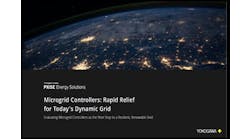The balancing act required on an increasingly renewable grid: How microgrids help
The U.S. ranked first in “renewable energy country attractiveness,” according to a report Can Decentralized Energy Get Good Enough, Fast Enough? from Ernst & Young Global Limited. It's a statistic that has meaning to the microgrid industry.
The report, which focuses on the most attractive global renewables markets with larger capital flows and capacity, placed the US at the top spot because of a combination of regulatory, financial and corporate support — which was recently boosted by the passage of the Inflation Reduction Act and the Bipartisan Infrastructure Law.
The nation also installed 23.6 GW of solar capacity, a 19% increase over 2020.
More renewables, more microgrids
These trends create increased demand for microgrids because of the role the technology plays in maintaining balance on a grid that increasingly relies on intermittent renewable energy.
Efforts to decarbonize and concerns about energy security are behind a move toward decentralized energy, said the report. And those drivers have become even more important with the war in Ukraine, where power outages have demonstrated the need for decentralized energy and microgrids.
Beyond energy security, microgrids play a kind of management role on a renewable grid which the report says faces "multiple new challenges."
Renewables and distributed energy resources (DERs) can cause unstable network conditions that can damage and reduce the lives of grid assets. They can also lead to voltage instability and capacity constraints when low demand combines with high DER output. If DERs cause sudden spikes and drops in power supply, the grid’s voltage and frequency levels can be disrupted, resulting in poor power quality. In the face of these challenges, network operators will be pressured more and more to find faster and less expensive ways to connect DERs to the grid, the report said.
Microgrids are viewed as a key to balancing intermittency, particularly where wind and solar play a larger role on the grid. As wind or solar ebbs and flows during the day, microgrids can quickly ramp up or down to help balance supply and demand on the grid.
The more renewables we have on the grid, the more we will need microgrids to manage the intermittency. That means renewable growth and microgrid growth go hand in hand, said Don Wingate, vice president, strategic customers and solutions, Microgrids North America, Schneider Electric.
Decommissioning of baseload generation, such as coal plants, and the addition of electric vehicle charging, puts strain on the grid too and exacerbates the challenges of intermittent power sources, Wingate said.
When the renewables are larger
And it's not only DERs that create imbalances. The same is true for grid-scale renewables. Fortunately, it's getting easier to add microgrids, as barriers to deployment are removed because of new regulations and business models such as energy as a service contracts, according to Wingate.
One example is a utility-scale microgrid that has slashed the use of diesel fuel and allowed for up to 70% renewables to serve a Portuguese Island, Graciosa.
The application is unique because the wind, solar and diesel resources in the microgrid all flow through the battery first, and the battery decides how to distribute the energy to the grid that supplies the whole island.
Meanwhile, the Inflation Reduction Act offers tax incentives for microgrids. And new advances in smaller, repeatable and scalable configured-to-order microgrid solutions are now coming to the market. These factors will make deployment of behind-the-meter microgrids commonplace and positioned to assist with grid resiliency, said Wingate.
Easing the peak
In addition to helping address the intermittency of renewables, microgrids can boost grid resiliency by helping cut usage during peak periods or providing clean electricity as an alternative to fossil fuel speaker plants, said Bill Schofield, vice president of future-grid services at Customized Energy Solutions.
Often, power plants are built to run only a few hours of the year to meet the demand from hot summer days when air conditioning use is high, he said. As a less expensive and cleaner alternative, microgrids can provide power from a clean resource or can reduce electric consumption during peak periods.
Role of EVs
Electric vehicles (EV) that are incorporated into microgrids can play an important role in helping integrate renewable energy, said Hemal Doshi, CEO and founder of Universal EV Chargers, a division of Universal Green Group.
“EV batteries within microgrids may offer opportunities to stabilize the grid by helping to smooth the peak-to-trough energy use curve,” he said. EVs could be charged at night when electricity is less expensive and then EV owners can sell some or all of the batteries’ electricity back to utilities during peak load periods.
And when EV batteries can no longer efficiently power EVs, they still could have a useful life as energy storage units.
“It is clear that electric grid operators have considerable opportunities to manage the grids more effectively, not just to meet the needs of a hot world but also to support the transition from internal combustion vehicles to EVs,” he said. Taking advantage of EV batteries can help grid operators delay new power plant installations that will ultimately be required to manage EV growth, he added.
Like EVs, energy storage in microgrids can play an important role in integrating renewable energy.
Key to net zero
Microgrids are powerful tools for cutting peak energy demand and also filling in the gaps from intermittent renewable resources, and are key to a net zero future, said Wingate. They can play a critical role as more renewables are added to the grid.
“Linking advanced microgrids to that growth trajectory will help mitigate the intermittency issues and provide a more distributed and resilient energy framework for the country,” Wingate said.
Do you have a story to tell about microgrids? Microgrid Knowledge is seeking speaker applications through Dec. 21 for Microgrid 2023: Lights On!, which will be held May 16-17, 2023 in Anaheim, California.








